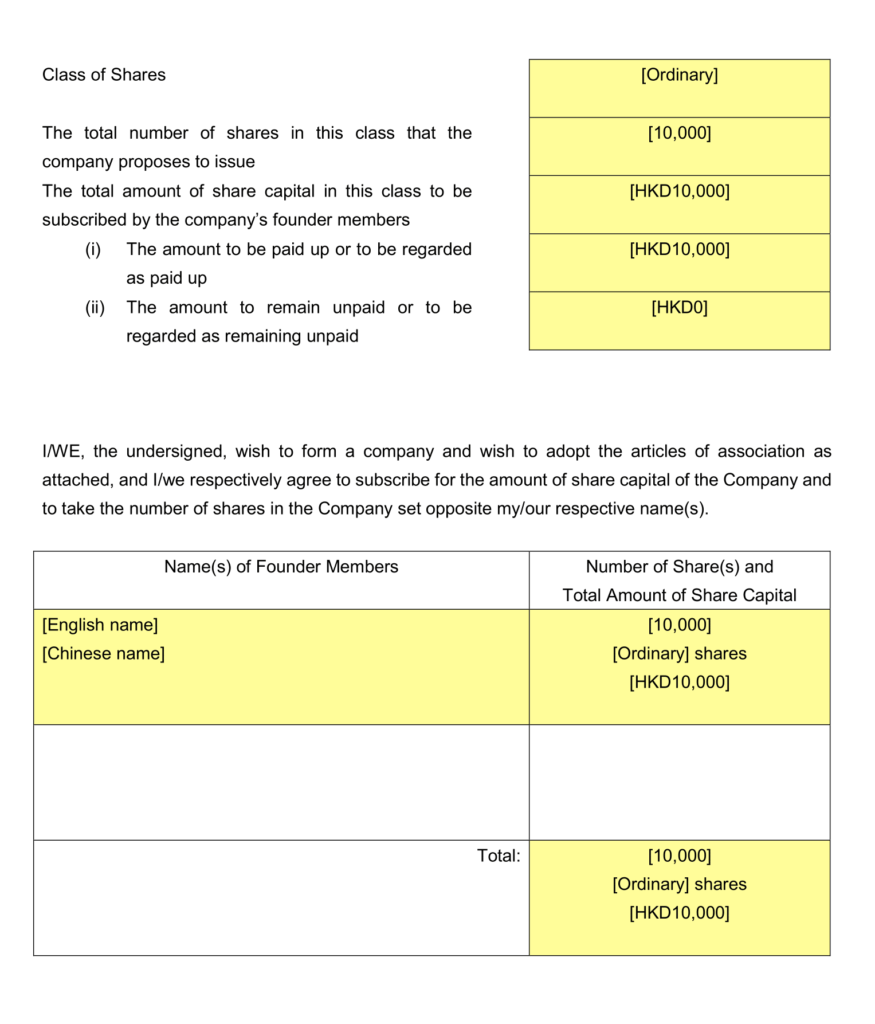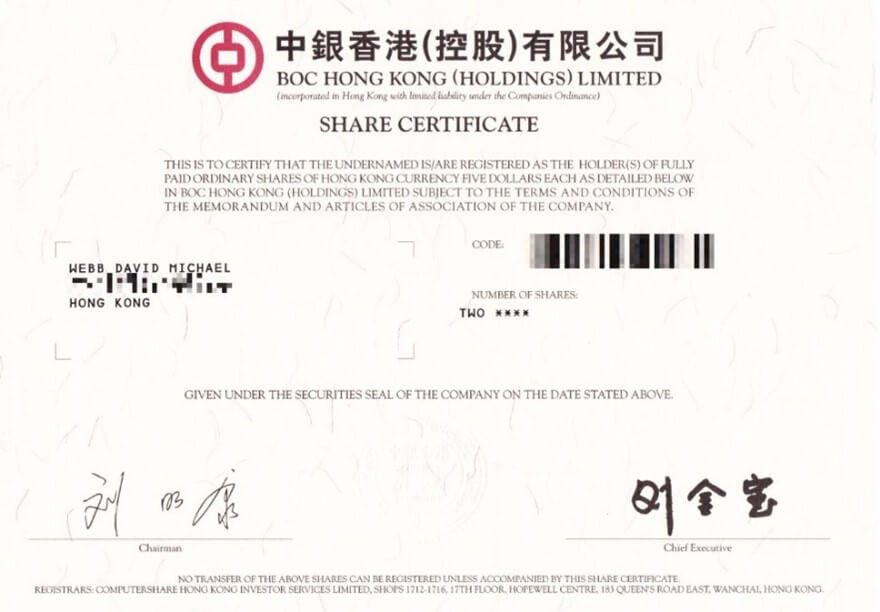什麼是公司章程?
公司章程是規範公司內部規則和治理的書面規定。香港公司註冊處對香港公司的公司章程有具體的法律要求,並包含一份公司章程樣本,任何人都可以用作模板並根據公司的需要進行調整。
本文中,我們將檢視公司註冊處提供的公司章程樣本中的關鍵部分,您將在公司營運中最常處理這些部分,並對其進行細分。
A部
章程細則必備條文
這些項目描述了公司的基本結構,包括公司名稱、成員的法律責任和分擔,以及股份結構。
項目1
公司名稱
公司章程的這部分載明了本文件管轄的公司的中文和/或英文名稱,根據公司成立時創建的商業登記文件。
項目2 及 3
成員的法律責任或分擔
本節規定,公司成員的責任僅限於其所持股份的未付金額。這意味著破產公司所欠的資金只能來自公司金庫,這就是有限公司「有限」部分的含義。
項目4
股份
本節討論公司股份,特別是擬發行的股份總數、已發行股份的類別以及已發行股份的初始分配。此處列出了公司創始成員的姓名以及向每位創始成員發行的股份數量。
公司章程樣本僅列出了普通股,但如果公司需要多於一類別的股票,並且股票附帶特殊權利,樣本章程中顯示的股票類別並不夠。股權結構、股權類別複雜的公司應依照公司的需求聘請律師來編製公司章程。

公司章程樣本中的股本錶示例。 資料來源:公司注册處
B部
章程細則其他條文
本部分的其他條文描述了公司董事及其高階主管的權力、如何做出決策、如何組織和召開會議、股份如何運作以及如何對公司進行變更。我們在這裡介紹了最必要的部分。
董事及公司秘書的權限
本節涵蓋公司董事和公司秘書的權力、權利和程序。項目3
董事的一般權限
公司董事擁有管理公司業務的一切權力,公司章程的任何修改不影響公司董事先前的行為。
項目4
成員的備留權力(特別決議)
雖然董事擁有一般權限,但股東可以通過特別決議,迫使公司董事採取特定行動,或限制董事採取某些行動。然而,特別決議不能使董事過去採取的行動無效。
項目5
董事可轉授權力
本節賦予公司董事將章程授予的任何權力委託給其他高階主管。董事甚至可以將權力委託給其他人,通常是公司秘書。正如他們有權委託這些權力一樣,他們也有能力取消其他職位擔當人的上述權力。
董事決策
項目8
召開董事會議
任何公司董事均有權透過向所有其他董事發出通知或授權公司秘書向所有董事發出通知的方式召開董事會議。向董事提供的通知應具體說明會議的詳細信息,例如建議的會議日期、時間和地點。該通知無需以書面形式。召開董事會議的原因有很多,但通常是為了進行績效評估、年度股東大會以及對公司動議進行投票。
項目9
參與董事會議
董事可以透過任何通訊方式或地點參加董事會議,這意味著董事遠端出席會議與親自出席會議具有相同的效果。
項目10
董事會議法定人數
法定人數是指董事會議被視為有效的最少董事出席人數。公司章程樣本將法定人數的最低董事人數規定為兩名,您可以在自己的公司章程中對此進行更改。如果公司只有一名董事,則該董事足以滿足法定人數,並且只能由該董事做出決定。
項目11
在董事總數少於法定人數下進行會議
如果未達到法定人數,則不能做出或接受任何決定或建議。唯一允許在沒有法定人數的情況下做出的決定是任命額外的董事或召開股東大會,以便股東可以任命額外的董事,從而達到法定人數。
項目12 及 13
主席在董事會議上的決定票
董事可以指定一名董事擔任會議主席。如果指定的主席缺席或在會議開始後 10 分鐘內不願主持會議,與會董事可以指定另一位主席作為替代。主席的職責是指導會議討論,以確保涵蓋所有目標主題,並在達到法定人數時管理決策投票。
如果出現僵局,當一項提案獲得雙方票數相等時,主席可以投下決定性一票來打破僵局。
項目14
利益衝突
根據香港《公司條例》第536條,當公司董事在董事會議討論的任何提案或交易中擁有個人利益時,該董事必須向其他董事披露其利益的性質和程度。然後,同一董事將被禁止投票或被計入達到法定人數。
董事仍可與公司簽訂合約或交易,但公司董事不能兼任審計師的角色。
項目17
備存決定的紀錄
根據《公司條例》,公司董事必須確保董事所做的每項決定都有書面記錄,保存期限為自決定日期起至少10年。
對於只有一名董事的公司,唯一董事仍必須保留所做決定的書面記錄。以書面決議形式作出的決定,書面決議可視為書面記錄。
董事的委任及卸任
項目20
董事的委任
如果一個人願意及法律允許擔任董事,則可以被任命為董事。該人士必須年滿 18 歲,可以透過普通決議或董事決定任命。
透過普通決議任命的董事可以無限期任職,但透過董事決定任命的董事必須在下一次年度股東大會上或公司財政年度結束後9個月內退休,並徵求重新任命。
項目22
董事停任
如果董事被法律禁止擔任董事、申請破產、精神上無行為能力、辭職、未經許可缺席董事會議超過6個月,或於普通決議中被罷免,該人即停任董事。
第 4 部
年度股東大會 (AGM) 和股東大會
項目28
成員大會
公司章程樣本規定,公司必須在每個財政年度舉行年度股東大會,以遵守《公司條例》對年度股東大會的要求。
公司董事也有權在必要時召集股東大會,就像股東也有權要求董事召開股東大會一樣。如果董事拒絕召開股東大會,根據《公司條例》,持有過半數投票權的股東有權自行召開股東大會。
項目29
成員大會的通知
要召開 AGM(年度股東大會),必須提前至少 21 天提供書面通知。股東大會必須至少提前 14 天發出書面通知。送達通知之日及會議召開之日不計入 21 天或 14 天。
該通知應提供予公司每位董事和股東及應向審核員提供該通知的副本。如果不小心遺漏了對任何人的通知,會議仍然被視為有效。
會議通知應包括以下內容:
- 會議日期和時間
- 該大會的舉行地點(無論是在實體地點還是虛擬地點舉行)
- 討論事項的概略性質
- 會議類型,是年度股東大會(AGM)還是股東大會
- 有關任何待討論決議的信息
- 通知會員有權委任代表的聲明
項目33
成員大會的法定人數
法定人數是指股東會被視為有效的最低股東出席人數。公司章程範例預設規定出席股東大會法定人數的最低股東為 2 名股東,無論是虛擬出席或現場出席。若公司只有一名股東,則該唯一股東就構成法定人數。如果沒有達到法定人數,唯一可以採取的行動是選舉會議主席。
項目36
延期
延期會議是將會議延後到另一個日期或時間。如果在董事召集的股東大會預定時間後 30 分鐘內未達到法定人數,將會休會。如果股東召集會議且在 30 分鐘內未達到法定人數,則會議將解散。
如果會議延期,董事必須確定延期會議的日期、時間和地點。如果在下一次延期會議期間仍未達到法定人數,則出席會議的成員將被視為達到法定人數。
項目37
在股東大會上投票
股東會的決議可以透過舉手方式進行。主席、至少 2 名股東或擁有至少 5% 總投票權的成員可以要求進行投票表決。在投票過程中,如果出現平票,會議主席將進行第二次決定性投票。
每個成員擁有的票數根據是舉手方式還是投票方式而有所不同。採用舉手投票時,每位出席的委員各有一票。以投票方式進行投票時,每位出席會議的成員對其持有的每一股股份都有一票。
項目43
委任股東會代理人
如果股東希望委託代表出席股東大會並代表其行事,則必須在會議召開前至少 48 小時發出書面委託通知。
委託書必須由股東代表認證或簽署,並應包括以下資訊:
- 股東姓名
- 股東地址
- 指定代表的身份
- 代表將出席的股東大會
根據《公司條例》第 605 條,如果股東委託代表但仍出席股東大會,則該代表的行事權將被撤銷。
股份發行、轉讓及配發

股份證書示例
項目49
發行股份
就向股東發行股份而言,股份必須繳足股款,且公司必須在發行後一個月內提交配發申報表通知公司註冊處。
項目54
轉讓股份
公司股份可以使用稱為[轉讓文書]的文件進行轉讓,公司可以在事後保留該文件的副本。如果股份轉讓給新股東,則在新股東的姓名記入股東名冊後,轉讓才會生效。
公司董事有權拒絕股份轉讓,但董事必須提供拒絕理由的說明。拒絕的原因可能包括轉帳程序不當或涉嫌詐欺。股東死亡時,公司可以認定已故股東的法定代理人持有其股份。
項目63
股份配發
經股東會決議批准,公司可以配發公司新股。
分派
項目64 – 69
宣布分派股息
根據《公司條例》,股利只能從公司利潤支付。宣布分派股息可以在股東大會上進行,股息必須根據宣布分派股息決議之日各成員的持股情況支付。股東也有權放棄獲得股利的權利。
股利可以採取其他非現金資產的形式,公司可以在普通決議批准後支付。
總結
公司章程對於規範香港公司的內部規則和運作起著至關重要的作用。這些書面規定依照香港《公司條例》的要求,為公司的結構、決策流程和成員之間的關係提供了框架。
上述各節重點介紹了公司註冊處提供的公司章程樣本的主要內容。然而,具有獨特需求或複雜股權結構的公司應尋求法律指導,以編製適合公司需求的客製化章程。










